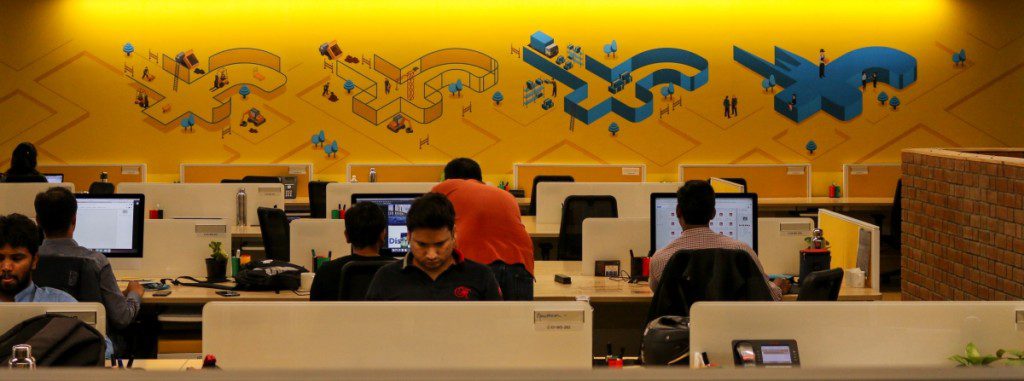Is the traditional office concept officially old news? The increase in shared workspaces and the value of brand collaboration has set a precedent for a move to innovative environments. Helped by virtual technologies and supported by the fresh flock of entrepreneurs, the virtual office is taking over the corporate space.

Corporate Collaboration
Some of the largest corporations are investing in research on collaboration to improve their team’s productivity. In their recent Management Manifesto, the Chartered Management Institute summarised productivity and business culture as key areas for collaborative action. Since then, a rise in co-working spaces and shared environments aimed at the corporate organisation have emerged. This trend allows individuals to effectively network with others in a creative environment and take inspiration from others in their field.
As opposed to the traditional serviced office, co-working hubs are a catalyst for change. As head of Level39, Ben Brabyn insists, “We have to champion open, vibrant communities that become platforms for innovation, change, and entrepreneurship.”
Tailored Activities
These innovative environments are blurring the lines between work and play as shared buildings feature an array of tailored activities that appeal to the sector’s residents. Some workspaces are focused on mindfulness and health while others attempt to inject leisure and entertainment in the form of hospitality facilities.
Traditional serviced offices haven’t remained stagnant as they have slowly evolved from “a hierarchical array of workstations, cubicles, and cabins to an open floor layout.” However, the experience-led millennial workforce has finally pushed past the confines of physical restraints and redesigned the idea of the office altogether.
Forward-thinking companies such as Swiss Re constructed their business plan to adopt values that link office design and culture. Recognising their correlation, the organisation addressed “the need to align HR policies, with workplace design, technological infrastructure, workplace practices, and corporate values and culture.” This holistic way of working is enabling companies to retain their millennial workforce who are easily bored and highly driven by corporate values above financial incentive.
An Abundance of Entrepreneurship
Entrepreneurship is at an all-time high “due to the explosion of technology in the past two decades” that spurred large firms to increase their ‘corporate venturing’ with start-ups. This abundance of entrepreneurship is surprisingly threatening to established organisations — hospitality company Airbnb has surpassed Hilton hotels and Uber has exceeded the market share of its automobile counterpart BMW.
Recent reports have revealed that business managers “must adopt a long-term outlook’, offering a proposition that is clear and tailored to the start-up company, which adds value to the collaboration. As businesses expand to work harmoniously, the relationships between firms have become increasingly complex. The most successful collaborative alliances are born out of detailed research that shows a reason to connect with one another has mutually beneficial possibilities.
A Global Workforce
Advancing technology allows us to take collaborative businesses to the next level by integrating communication streams, task management and communication in digital forms for remote access. As the world becomes increasingly connected, our heightened awareness of global matters demands a separation from corporate tradition. Business leaders are recognising the need for a more fluid workforce, as major stakeholders like Coca-Cola “agree on the need for an increased level of collaborations on Research and Development for sustainable economic development.”
As we move forward with huge developments that will affect mainstream business, the growth of AI has become a group effort with the likes of Microsoft, Adobe and SAP working on joint projects to “drive AI use”.
A Virtually Assisted Workforce
On a small scale, technology experts predict that with remote working becoming the norm, new technologies will be in demand. As 26% of Americans currently engage with podcasts at least once a month, it is thought that this consumer trend could become valuable to a shared corporate audience. Allowing companies to create and track content that engages their workforce will become a virtual way to replace traditional learning and development practices. This method allows leaders to gain insights on the traffic of each uploaded audio, successfully tracking engagement to determine it’s a “logical replacement for print.”
Virtual call management technology is already being utilised by companies that encourage virtual work environments. Business phone systems give companies the freedom to do business anywhere enabling a smooth transition towards working environments that increase productivity and collaboration. While a whole host of technology will eventually become the fabric of remote companies, essential communications such as call handling systems are readily available from specialist providers like eReceptionist.
As serviced offices fade into the distance, leaders can take advantage of new technologies to break free from the confines of their office cubicles and explore the virtual world of remote work.
[About the author: Rory Whelan is a communications expert with over twenty years experience in consultancy, television, media and telecoms. Since 2012 he has held the role of marketing manager for eReceptionist, leading the product to become the favourite call management company for UK SMEs.]